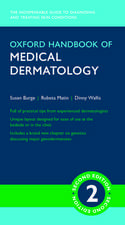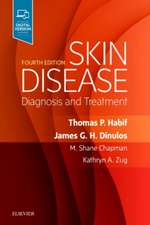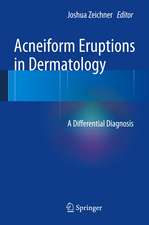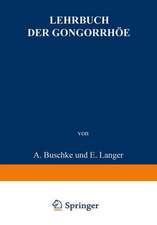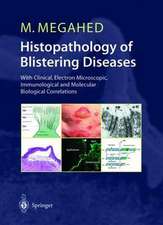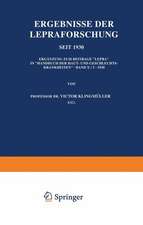Dermatological Atlas of Indigenous People
Autor Marcos Cesar Florian, Jane Tomimori, Sofia Beatriz Machado de Mendonça, Douglas Antonio Rodriguesen Limba Engleză Hardback – 2 oct 2017
This Atlas addresses that gap by providing specific materials for professionals involved in the health of indigenous people, especially with those who live either alone or in remote areas. It offers a comprehensive overview of the most common skin diseases in specific tribes, providing a full clinical guide on the dermatologic signs and symptoms in these individuals. Additionally, the book complements the clinical standpoint with an anthropologic perspective, examining the impact of dermatologic diseases in indigenous people and the different meaning of these diseases in their lives. Most of the material presented in this Atlas was collected in the Xingu Program, a project created in 1965 by the Federal University of São Paulo, Brazil, and devoted to providing medical care to indigenous people from the Upper Xingu region, in the heart of the Amazon rainforest. Thus, the content is primarily applicable to South American indigenous people. However, the common characteristics of the isolation and non-urbanization of these communities, as well as the anthropologic perspective adopted here, allow the content to be extrapolated to other indigenous peoples worldwide. This Atlas will be a novel and valuable resource for health professionals who work with indigenous peoples, especially in geographic areas where dermatologists are not always readily available.
Preț: 1097.71 lei
Preț vechi: 1155.48 lei
-5% Nou
Puncte Express: 1647
Preț estimativ în valută:
210.04€ • 219.32$ • 173.45£
210.04€ • 219.32$ • 173.45£
Carte disponibilă
Livrare economică 25 martie-08 aprilie
Preluare comenzi: 021 569.72.76
Specificații
ISBN-13: 9783319594446
ISBN-10: 3319594443
Pagini: 152
Ilustrații: XI, 87 p. 183 illus., 91 illus. in color.
Dimensiuni: 210 x 279 mm
Greutate: 0.5 kg
Ediția:1st ed. 2017
Editura: Springer International Publishing
Colecția Springer
Locul publicării:Cham, Switzerland
ISBN-10: 3319594443
Pagini: 152
Ilustrații: XI, 87 p. 183 illus., 91 illus. in color.
Dimensiuni: 210 x 279 mm
Greutate: 0.5 kg
Ediția:1st ed. 2017
Editura: Springer International Publishing
Colecția Springer
Locul publicării:Cham, Switzerland
Cuprins
1. The social representation about the body, the skin and the skin diseases from the Indigenous thinking.- 2. A brief history of the Indigenous people of South American.- 3. A brief history of the Xingu National Park, Central Brazil.- 4. Elementary skin lesions in the dermatological medical examination.- 5. Infectious diseases.- 5.1. Fungal diseases.- 5.1.1. Dermatophytosis and Granuloma trichophyticum.- 5.1.2. Paronychia.- 5.1.3. Pityriasis versicolor.- 5.1.4. Tinea imbricate.- 5.1.5. Black piedra.- 5.1.6. Lobomycosis.- 5.1.7. Chromoblastomycosis.- 5.1.8. Mycetoma.- 5.2. Bacterial diseases.- 5.2.1. Impetigo.- 5.2.2. Bacterial folliculitis.- 5.2.3. Erisypela and Cellulitis.- 5.2.4. Furunculosis and Abscess.- 5.2.5. Cutaneous Mycobacteriosis.- 5.3. Virus diseases.- 5.3.1. Warts.- 5.3.2. Focal epithelial hyperplasia.- 5.3.3. Condyloma acuminatum.- 5.3.4. Moluscum contagiosum.- 5.3.5. Herpes simplex.- 5.3.6. Herpes zoster.- 5.4. Parasitic diseases.- 5.4.1. Scabiosis.- 5.4.2. Pediculosis.-5.4.3. Larva migrans cutaneous.- 5.4.4. Tungiaisis.- 5.4.5. Leishmaniasis.- 6. Inflammatory diseases.- 6.1. Pityriasis alba.- 6.2. Eczematids.- 6.3. Miliaria.- 6.4. Contact dermatitis.- 6.5. Seborrheic dermatitis.- 6.6. Neurodermatitis.- 6.7. Psoriasis.- 6.8. Prurigo.- 6.9. Urticaria.- 6.10. Fixed drug eruption.- 7. Neoplastic diseases.- 7.1. Seborrheic keratosis.- 7.2. Melanocytic naevi.- 7.3. Mucous cysts.- 7.4. Pigmented basocellular carcinoma.- 7.5. Spinocellular carcinoma.- 8. Genetic diseases.- 8.1. Epidermolysis bullosa.- 8.2. Peutz-Jeghers syndrome.- 9. Miscellaneous diseases.- 9.1. Hypertrophic scars and Keloids.- 9.2. Lichen striatus.- 9.3. Endemic pemphigus foliaceus (“wild fire”).- 9.4. Geographic tongue.- 9.5. Fox-Fordyce disease.- 9.6. Hydroa vacciniforme.
Notă biografică
Marcos César Floriano: MD (1991), MSc in Dermatology (2000) and PhD in Sciences(2014) by the Federal University of São Paulo (UNIFESP), Brazil. Specialization in Dermatology by the Brazilian Society of Dermatology (1995) and in Leprosy by the Brazilian Society of Hansenology (1997). Assistant doctor, head of leprosy group and head of indigenous people health clinic at Department of Dermatology, UNIFESP. Professor and coordinator of undergraduate course in Medicine – Universidade Nove de Julho.
Jane Tomimori: MD (1983), MSc in Dermatology (1992) and PhD in Sciences(1995) by the Federal University of São Paulo (UNIFESP), Brazil. Specialization in Dermatology by the Brazilian Society of Dermatology (1987). Post-doctoral fellowship in Dermatology at Universität Müster, Germany. Professor of Medicine and deputy headship of the Department of Dermatology, UNIFESP. Member of the editorial board of Anais Brasileiros de Dermatologia and International Journal of Dermatology.
Douglas Antonio Rodrigues: MD (1979), specialization in Social and Preventive Medicine (1983) and PhD in Public Health (2010) by the Federal University of São Paulo (UNIFESP), Brazil. Head of Xingu Program, a program from UNIFESP devoted to provide health care to indigenous people from the Xingu region, Amazon Forest. Head of the Special Interest Group in Indigenous Health and manager of the indigenous people health clinic - UNIFESP.
Sofia Beatriz Machado de Mendonça: MD by Federal University of São Paulo (1983), specialization in Social and Preventive Medicine (1983), MSc in Social Sciences by PUC-SP (1996). Head of Indigenous and non-indigenous human resources department – Xingu Program
Jane Tomimori: MD (1983), MSc in Dermatology (1992) and PhD in Sciences(1995) by the Federal University of São Paulo (UNIFESP), Brazil. Specialization in Dermatology by the Brazilian Society of Dermatology (1987). Post-doctoral fellowship in Dermatology at Universität Müster, Germany. Professor of Medicine and deputy headship of the Department of Dermatology, UNIFESP. Member of the editorial board of Anais Brasileiros de Dermatologia and International Journal of Dermatology.
Douglas Antonio Rodrigues: MD (1979), specialization in Social and Preventive Medicine (1983) and PhD in Public Health (2010) by the Federal University of São Paulo (UNIFESP), Brazil. Head of Xingu Program, a program from UNIFESP devoted to provide health care to indigenous people from the Xingu region, Amazon Forest. Head of the Special Interest Group in Indigenous Health and manager of the indigenous people health clinic - UNIFESP.
Sofia Beatriz Machado de Mendonça: MD by Federal University of São Paulo (1983), specialization in Social and Preventive Medicine (1983), MSc in Social Sciences by PUC-SP (1996). Head of Indigenous and non-indigenous human resources department – Xingu Program
Textul de pe ultima copertă
Skin diseases are highly prevalent among indigenous people, leading to low mortality but greatly impacting their quality of life. Such diseases can be observed in indigenous people; both those living in isolated communities and those who have since been urbanized to some degree share a common characteristic of presenting different clinical patterns than non-indigenous individuals. These specificities necessitate a special approach when diagnosing dermatologic diseases in indigenous people. However, these considerations are rarely discussed in standard dermatology books.
This Atlas addresses that gap by providing specific materials for professionals involved in the health of indigenous people, especially with those who live either alone or in remote areas. It offers a comprehensive overview of the most common skin diseases in specific tribes, providing a full clinical guide on the dermatologic signs and symptoms in these individuals. Additionally, the book complements the clinical standpoint with an anthropologic perspective, examining the impact of dermatologic diseases in indigenous people and the different meaning of these diseases in their lives. Most of the material presented in this Atlas was collected in the Xingu Program, a project created in 1965 by the Federal University of São Paulo, Brazil, and devoted to providing medical care to indigenous people from the Upper Xingu region, in the heart of the Amazon rainforest. Thus, the content is primarily applicable to South American indigenous people. However, the common characteristics of the isolation and non-urbanization of these communities, as well as the anthropologic perspective adopted here, allow the content to be extrapolated to other indigenous peoples worldwide. This Atlas will be a novel and valuable resource for health professionals who work with indigenous peoples, especially in geographic areas where dermatologists are not always readily available.
Caracteristici
The first atlas of dermatological disease specifically devoted to indigenous people Offers concrete support for dermatologists, physicians and nurses who work with isolated communities, especially with indigenous people Features completely unique content, including data collected during the Xingu Project expeditions to the Amazon rainforest Includes supplementary material: sn.pub/extras

